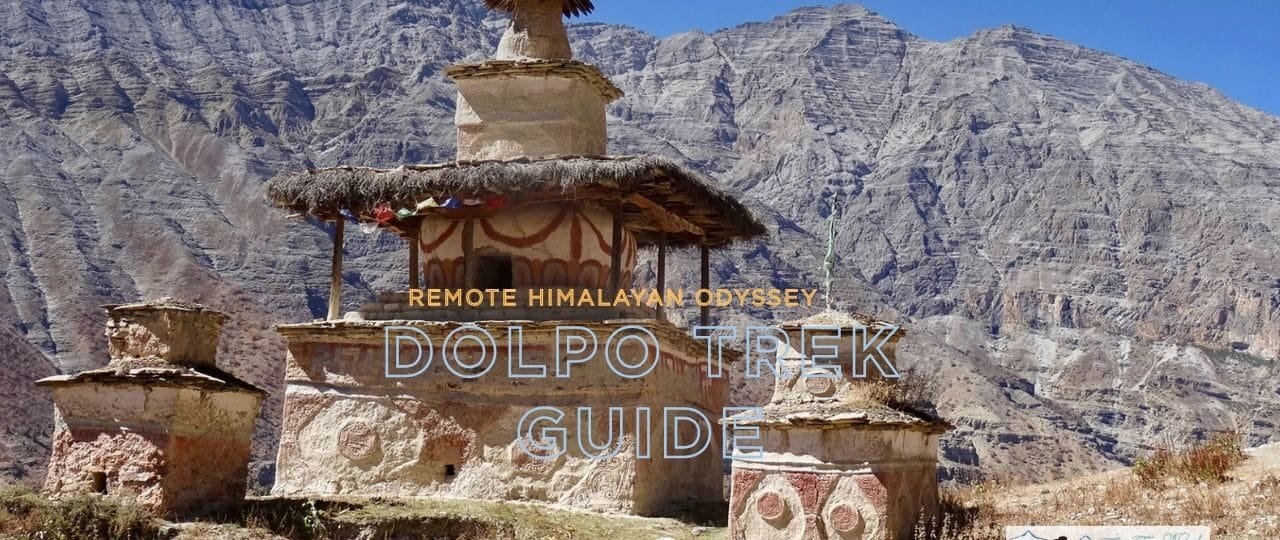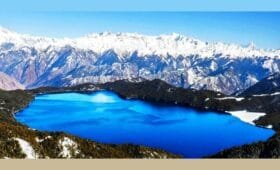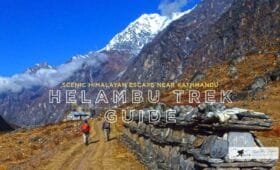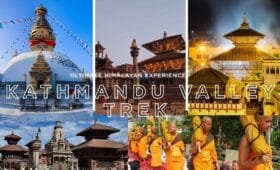The Dolpo Trek is one of Nepal’s most mysterious and awe-inspiring adventures. Tucked into the nation’s northwest corner, Dolpo remains a sanctuary for timeless Tibetan-influenced culture, unspoiled valleys, and towering peaks. Many trekkers dream of exploring the Shey Phoksundo region and the high passes that mark the Dolpo Trek Route, yet few venture here due to logistical hurdles. However, for the bold, Dolpo Trek promises a mesmerizing mixture of high-altitude deserts, turquoise lakes, hidden monasteries, and encounters with traditional lifestyles seldom witnessed in more frequented trekking areas.
In this comprehensive Dolpo Trek Guide article, we’ll delve into all facets of the Dolpo Trek: from the typical Dolpo Trek Itinerary to cost, difficulty, best times to visit, essential tips, and how you can merge your trek with philanthropic efforts through Volunteers Initiative Nepal (ViN). Additionally, we’ll highlight the synergy between Shey Phoksundo Trek and Upper Dolpo Trek routes, offering deeper perspectives on the region’s cultural and ecological wealth. Whether you’re a seasoned trekker craving undiscovered trails or an explorer aiming for a profound cultural immersion, the Dolpo Trek reveals an unspoiled Himalayan realm that can leave lifelong memories.
Introduction
1. Introduction: Why Choose Dolpo Trek?
Overshadowed by more mainstream Everest or Annapurna treks, Dolpo has remained largely off the beaten path. The region’s hallmark, Shey Phoksundo Lake Trek, draws adventurers eager for an unspoiled wilderness. This serene lake within Shey Phoksundo National Park encapsulates Dolpo’s unadulterated charm. Meanwhile, the broader Dolpo Trek weaves around higher passes, remote enclaves, and centuries-old Buddhist or Bon monasteries perched in stark trans-Himalayan landscapes.
Statistic: According to Nepal’s Department of Tourism, under 2,000 foreign trekkers visit the Dolpo region annually, making it one of the country’s least visited but most pristine trekking destinations. Here, local communities maintain Tibetan roots, speak Tibetan dialects, and remain intimately entwined with yak herding and high-altitude trade routes. For travelers, the reward is the sheer magnificence of nature untrammeled by large crowds, culminating in an intimate journey unlike any other in Nepal.
Quote:
“The Dolpo Trek changed my view of what Himalayan trekking could be—vast arid valleys, turquoise Shey Phoksundo, and unbelievably rich Tibetan culture,” recalls Martina, a 32-year-old trekker from Germany who completed the route last year.
History
2. Historical & Cultural Overview
Historically known as Dolpo (or Do Tarap), the region has deep Tibetan roots. Many local inhabitants, known as Dolpo-pa, emigrated from Tibet centuries ago and retained an ancient Tibetan dialect alongside a strong Buddhist or Bon spiritual heritage. Shey Phoksundo National Park, covering much of Lower and Upper Dolpo, preserves the natural wonders and these cultural artifacts, from prayer-flagged passes to intricately carved mani walls.
The seat of Dolpo’s spiritual tapestry is Shey Gompa (“Crystal Monastery”), often visited on extended variants of the Dolpo Trek or Upper Dolpo Trek. This revered monastery, perched in a remote corner near the Shey Phoksundo region, has long drawn pilgrims seeking blessings and more profound spiritual experiences. Today, trekking routes also reflect these ancient trade paths that once linked Dolpo with neighboring Tibetan regions for salt, wool, and daily goods. Despite modern influences, Dolpo remains a living cultural museum.
Trek Itinerary
3. Key Highlights of Dolpo Trek Itinerary
Though no single Dolpo Trek Itinerary fits all, two main routes stand out:
- Lower Dolpo Trek
- Focuses on Shey Phoksundo Lake Trek highlights, generally 10–14 days.
- It starts from Juphal airstrip, passes Dunai (~2,140m), and then ascends to Ringmo village near Shey Phoksundo (~3,611m).
- It often crosses minor passes, like the Kagmara La (~5,115m) or Baga La (~5,170m), leading into hidden valleys.
- Upper Dolpo Trek
- Demands more time (18–25 days).
- It includes Shey Gompa, crossing higher passes above 5,000m, culminating in a loop or continuing into Mustang.
- Involves advanced logistical planning and additional restricted-area permits.
Dolpo Trek Duration typically ranges from 10 days (short Lower Dolpo emphasis) to nearly a month (entire Upper Dolpo route). The distances vary, with daily trekking around 5–7 hours. Teahouses are scarce, so many groups rely on camping. Some semi-teahouse routes exist in Lower Dolpo, especially near Phoksundo Lake.
Trek Difficulty
4. Understanding the Dolpo Trek Difficulty
Dolpo Trek Difficulty registers high. The region’s remoteness, altitude, and limited facilities create unique challenges:
- High Passes: If you include Kagmara La, Baga La, or Kang La, expect altitudes above 5,000m. This demands strong cardio fitness, gradual acclimatization, and caution about altitude sickness.
- Minimal Infrastructure: Lower Dolpo has some teahouses, but the route can still require partial or complete camping. Transportation to the start point (Juphal) can be flight-dependent and prone to cancellations.
- Rugged Trails: Trails often cross arid landscapes, glacial valleys, and scree slopes. Confidence in rough terrain is key, and trekking poles are recommended.
Trekkers typically handle daily ascents and descents of ~600–900 meters. Pre-trek conditioning—cardio, strength, some multi-day altitude trekking experience—enhances your success and comfort.
Shey Phoksundo Trek
5. Shey Phoksundo Trek: A Centerpiece of Dolpo
Among the region’s main draws, the Shey Phoksundo Trek is a shorter subset of Dolpo’s offerings. This route:
- Emphasizes Shey Phoksundo Lake (~3,611m): widely hailed for its turquoise color and spiritual importance.
- Passes within Shey Phoksundo National Park, home to the elusive snow leopard, Himalayan musk deer, and dozens of bird species.
- It usually spans 8–10 days, starting from Juphal, culminating in a rest day near the lake to soak in the sublime calm before returning.
For many adventurers uncertain about tackling whole Upper Dolpo Trek heights, Shey Phoksundo Lake Trek offers a more moderate but equally enchanting alternative. The daily distances remain manageable, and altitude rarely climbs beyond ~4,500m if you skip the higher passes.
Trek Experience
6. The Upper Dolpo Trek Experience
Upper Dolpo Trek raises the stakes for travelers craving deeper immersion. Highlights include:
- Shey Gompa (~4,126m): Known as the “Crystal Monastery,” a revered site for Tibetan Buddhism.
- High Pass Crossings: Kang La (~5,350m), Saldang La (~5,200m), and others push your stamina but reward you with stark, trans-Himalayan panoramas.
- Rare Cultural Interactions: Through villages like Saldang or Tinje, you witness lifestyles shaped by minimal farmland, yak herding, and salt-wool trade.
Due to restricted-area rules, special Dolpo Trek Permits (e.g., for upper sections) and compulsory local guides are needed. This route can exceed 20 days, making it among Nepal’s most demanding treks, but it yields matchless solitude and an immersive Tibetan cultural sphere.
Trek Costing
7. Understanding the Dolpo Trek Cost
Dolpo Trek Cost outpaces many standard Nepal treks, primarily due to restricted-area permit fees, flights, and logistical demands. Key factors:
- Permits
- Lower Dolpo region demands a National Park entry (~USD 30) plus a TIMS or other local permit.
- The upper Dolpo zone requires restricted permits, typically ~USD 500 per person for the first 10 days (and ~USD 50 for each additional day). Rules change; confirm at the Nepal Tourism Board.
- Flights
- Most start from Kathmandu → Nepalgunj → Juphal, each flight ~USD 100–200 each way.
- Frequent delays or cancellations, so buffer days might be needed.
- Guide & Porters
- A Dolpo Trek Guide is mandatory for restricted regions. Expect ~USD 25–30/day for a guide, plus ~USD 15–25/day for porters.
- Food & Accommodation
- In Lower Dolpo, some teahouses exist (~USD 5–10/night), while advanced or Upper Dolpo routes use camping with staff-provided meals.
- Imported items can spike meal costs; daily budgets might be ~USD 20–35.
All told, a two-week Lower Dolpo trek can cost ~USD 1,500–2,000. An Upper Dolpo Trek exceeding three weeks could cost ~USD 3,000–4,000, primarily due to restricted permits, gear, staff wages, and numerous flights.
Trek Map
8. Dolpo Trek Map & Route Overviews
A reliable Dolpo Trek Map helps you choose your route variant. The region’s main entry:
- Juphal (~2,475m): A short flight from Nepalgunj leads to a small airstrip.
- Dunai (~2,140m): District headquarters of Dolpa, the usual first overnight.
- Lower Dolpo: Heading to Shey Phoksundo Lake, typically crossing minor passes around 3,500–4,000m.
- Upper Dolpo: Venturing beyond the lake, crossing high passes exceeding 5,000m, eventually looping or exiting near Mustang or other remote areas.
- Shey Phoksundo Lake (~3,611m): The route’s mesmerizing epicenter for shorter, more scenic treks.
Dolpo Trek Distance can range from ~80–120 km for Lower Dolpo to 200+ km for a complete Upper Dolpo circuit. You’ll ascend or descend ~400–800m daily, with a typical 5–7 hours of walking.
Weather
9. Best Seasons & Dolpo Trek Weather
Dolpo’s high-altitude desert climate diverges from typical Himalayan norms. The recommended time frames:
- Spring (Mar–May): Snow melts, passes open, and temperatures moderate. Early spring might see leftover snow at altitude but clear vistas.
- Autumn (Sept–Nov): Generally stable weather, crisp days, minimal monsoon leftover. Nights can approach freezing at ~4,000m. Peak trekking is in demand, so plan.
- Winter (Dec–Feb): Sub-zero nights, heavy snowfall closing passes. It is rarely recommended unless you’re prepared for winter camping and potential route blockages.
- Monsoon (Jun–Aug): Dolpo’s partial rain shadow means less rainfall than other regions. However, flights remain uncertain, and some trails might still be muddy or risk landslides.
Dolpo Trek Weather near Shey Phoksundo can be relatively mild in autumn, around 10–15°C daily, dipping near 0°C at night. Pass areas can be windy, so layering is crucial.
Safety
10. Altitude & Safety on Dolpo Trek
Dolpo Trek Altitude typically peaks around 5,000–5,500m for advanced passes, while the lake area (~3,611m) is more moderate. Key safety tips:
- Acclimatization: Plan rest days for ~4,000m if crossing multiple passes.
- Hydration: Drink 2–3 liters daily. A mild headache or fatigue might be early signs of altitude sickness.
- Slow Ascent: Avoid sharp altitude jumps; maintain a measured daily gain of ~300–500m.
- Medical Gear: A basic medication kit, plus knowledge of Diamox usage for altitude prophylaxis, can be helpful.
Dolpo Trek Permits mandate a licensed guide for restricted sections. This guide ensures route safety, avalanche or landslide awareness, and immediate altitude sickness responses if needed.
Trek Accommodation
11. Gear & Lodging: Dolpo Trek Accommodation
Due to Dolpo’s remoteness, teahouse options remain limited:
- Lower Dolpo: Some Juphal, Dunai, and Ringmo teahouses near the lake. Basic rooms, local meals (dal bhat, noodles, potatoes).
- Upper Dolpo: Primarily camping, with porters and a cook. Lodges often do not exist in far-flung villages.
- Extra Essentials: A warm sleeping bag (comfort rating ~-10°C or better), good trekking boots, multiple layers. A four-season tent and expedition-level jacket might be needed if you plan advanced passes.
Dolpo Trek Accommodation might cost ~USD 5–10 in Lower Dolpo teahouses. The cost is bundled within the package on fully guided or group treks with camping. Solar-charged or generator-based electricity might be scarce, so bring extra power banks.
FAQs
12. Common FAQs About Dolpo Trek
Below are the top queries travelers often ask, gleaned from Google and trekking forums:
How long is the Dolpo Trek Duration?
It takes 10–14 days to reach Lower Dolpo and 18–25 days to reach Upper Dolpo. However, if you focus only on the lake area, Shey Phoksundo Lake can be done in ~9–10 days.
What is the Dolpo Trek Difficulty?
High. In upper routes, altitudes surpass 5,000m, and rugged terrain and minimal facilities are encountered. Good fitness and prior multi-day trekking are recommended.
How much does the Dolpo Trek Cost?
Expect ~USD 1,500–2,000 for Lower Dolpo (~2 weeks). Upper Dolpo can surpass ~USD 3,000–4,000, factoring in restricted permits, flights, and extended guide/porter wages.
Do I need special Dolpo Trek Permits?
Yes. Shey Phoksundo National Park entry (~USD 30), plus restricted-area permit fees for Upper Dolpo (~USD 500 for the first 10 days). A local guide is mandatory in restricted regions.
When is the best time for Dolpo Trek?
Spring (March) or autumn (Sept–Nov) for stable weather. Winter sees heavy snow; monsoons pose flight disruptions, though Dolpo’s partial rain shadow can reduce rainfall.
Is a Dolpo Trek Guide required?
Yes, for Upper Dolpo (restricted area rules). For Lower Dolpo, it’s optional but recommended to navigate lesser-known routes, manage altitude, and handle cultural translation.
What about lodging and food on the trek?
Lower Dolpo has sporadic, basic teahouses. Upper Dolpo is primarily camping-based. Meals revolve around local produce—dal bhat, noodles, potatoes, and your cooking crew if camping.
Tips
13. Tips for an Enriching Dolpo Trek
13.1 Proper Conditioning & Packing
- Conditioning: Start a hiking routine with a loaded backpack, plus cardio and strength.
- Packing: Bring a down jacket, layered clothing, sturdy boots, personal medication, purifier tablets, plus extra camera batteries.
13.2 Cultural Respect
- Language: Many speak a Tibetan dialect. Learn basic Nepali greetings or Tibetan phrases to connect with locals.
- Monastery Etiquette: Remove shoes and hats; ask before photos, especially inside gompas.
13.3 Minimizing Environmental Impact
- Carry In, Carry Out: Trash disposal is limited.
- Filter/Boiled Water: Cut plastic bottle use.
- Dolpo Trek Tips: Tread lightly on farmland, respect wildlife, and donate responsibly if you want to leave beneficial footprints.
13.4 Prepare for Weather & Delays
Flexible Itinerary: High passes sometimes require extra rest if storms or heavy snow impede crossing.
Buffer Days: Juicy flights or bus rides can be delayed.
Community Impact: Trekking with Volunteers Initiative Nepal
A unique highlight of traveling in Nepal is the chance to merge personal adventure with local community upliftment. Volunteers Initiative Nepal (ViN) organizes charity trekking and travel tours, ensuring that all proceeds go to community empowerment if travelers join these programs. Your trek transforms into a double-impact journey: satisfying your wanderlust while fueling grassroots developments.
14.1 Volunteering, Internship, & Donations
- Volunteer: Teach English or computer skills, help local health clinics, or support women’s empowerment in remote Dolpo villages.
- Internship: Combine academic pursuits—cultural research, sustainable agriculture, or environmental studies—with on-ground community projects, bridging theory and practice.
- Donate: Even small financial contributions or supplies can expedite local improvements in schooling, water systems, or micro-infrastructure. This synergy fosters fundamental changes that outlast your trek.
14.2 Share Your Trek with Friends & Families
Encourage your circle to travel responsibly. By highlighting Dolpo’s serene beauty and urgent community needs, you help raise awareness for mindful tourism—ensuring each footprint yields positivity for locals and the fragile environment.
Conclusion
From desert-like valleys overshadowed by Himalayan giants to the turquoise calm of Shey Phoksundo Lake Trek, the Dolpo Trek unravels an otherworldly panorama. Yet it’s more than a scenic foray: centuries-old Tibetan traditions, rare wildlife sightings, and an inimitable sense of seclusion define Dolpo’s essence. Unlike the typical bustle of Everest or Annapurna, Dolpo offers a quieter, more introspective sojourn that can profoundly reshape how you view Himalayan adventure.
By weaving philanthropic synergy with your trek—through volunteering, donation, or internship with ViN—you magnify the meaning of your journey, forging a beneficial legacy for the region. The Dolpo Trek thus transcends mere tourism, bridging hearts between visitors and locals, ensuring these remote enclaves can flourish while retaining their cultural identity.
Namaste—may your footsteps across Dolpo’s sacred passes and the shores of Phoksundo echo with empathy, empowerment, and unforgettable wonder.
Additional Practical Guidance
Extended Practical Guidance & Final Encouragement
For adventurers craving a deeper dive, let’s finalize the essential details:
1. Route Variation & Splits
1.1 Shey Phoksundo Lake Trek
An 8–10 day route from Juphal to the lake and back. Suitable for moderate fitness; altitudes ~3,600–4,000m. Minimally restricted permits, though some local fees apply.
1.2 Upper Dolpo Trek
Spans 2–3 weeks, crossing multiple 5,000m+ passes. Demands restricted permits, advanced camping logistics, and high-altitude gear.
2. Gear Recap
- Footwear: High-ankle boots with reliable soles for scree.
- Layering: Thermals, fleece, down jacket, windproof outer shell. Nighttime near 0°C or sub-zero above 4,000m.
- Camping Equipment: If you do the full Upper Dolpo, expect to carry a tent, sleeping mat, four-season bag, and cooking essentials unless you are using robust expedition support.
3. Cultural Etiquette
- Photography: Politely request permission before capturing locals, especially monks or nuns around Shey Gompa.
- Monastery Donations: Small monetary offerings or candles show respect.
- Barter vs. Purchase: Some local trades might prefer direct change; gentleness needed negotiating to maintain harmonious relations.
4. Travel & Insurance
- Emergency Evacuation: Helicopter rescue from Dolpo is costly and reliant on suitable weather. Comprehensive insurance covering ~5,500m altitudes and rescue is vital.
- Language: Basic Nepali or Tibetan phrases foster rapport. Many in Dolpo speak Tibetan dialects, though guides or interpreters help bridge communication gaps.
5. Future Directions
Once you’ve tasted Dolpo’s charm, other remote provinces, such as Rara Lake or Limi Valley, beckon. Each shares a similar tapestry of unspoiled wilderness, unique cultures, and enthralling highland sceneries. Continuing your philanthropic efforts can unify your travels with altruism, setting a shining example of responsible tourism in a quickly shifting world.




